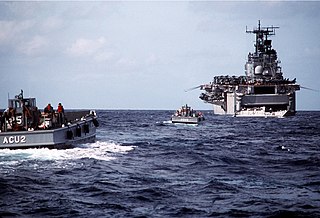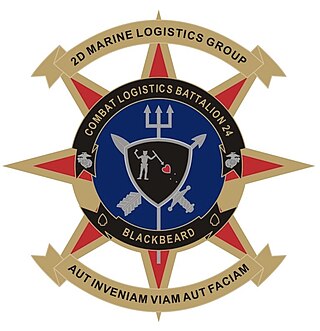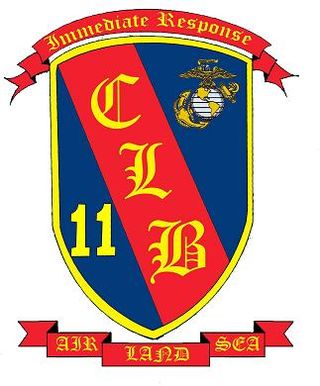
A Marine expeditionary unit is the smallest air-ground task force (MAGTF) in the United States Fleet Marine Force. Each MEU is an expeditionary rapid reaction force ready to answer any crisis, whether it be disaster aid or a combat mission. Marine amphibious unit (MAU) was the name used until the late 1980s.

Operation Sharp Edge was a non-combatant evacuation operation carried out by the 22nd Marine Expeditionary Unit and 26th MEU of the United States Marine Corps in Liberia in 1990 and 1991. The MEUs were supported by Amphibious Squadron Four composed of USS Whidbey Island, USS Saipan, USS Ponce, USS Sumter, USS Barnstable County, USS Peterson, and Fleet Surgical Team TWO.

III Marine Expeditionary Force is a formation of the Marine Air-Ground Task Force of the United States Marine Corps. It is forward-deployed and able to rapidly conduct operations across the spectrum from humanitarian assistance and disaster relief (HA/DR) to amphibious assault and high-intensity combat.

The 22nd Marine Expeditionary Unit is one of seven such units currently in existence in the United States Marine Corps. It is a Marine Air Ground Task Force with a strength of about 2,200 personnel. They are currently based out of Marine Corps Base Camp Lejeune, North Carolina and fall under the command of the II Marine Expeditionary Force. It is the most decorated of the U.S. Marine Corps' seven MEUs.
In the United States Marine Corps, a Marine Air–Ground Task Force is the principal organization for all missions across the range of military operations. MAGTFs are a balanced air–ground, combined arms task organization of Marine Corps forces under a single commander that is structured to accomplish a specific mission. The MAGTF was formalized by the publishing of Marine Corps Order 3120.3 in December 1963, "The Marine Corps in the National Defense, MCDP 1-0". It stated:
A Marine air–ground task force with separate air ground headquarters is normally formed for combat operations and training exercises in which substantial combat forces of both Marine aviation and Marine ground units are included in the task organization of participating Marine forces.

The 7th Engineer Support Battalion is an engineer support unit of the United States Marine Corps and is headquartered at Marine Corps Base Camp Pendleton, California. The unit falls under the command of 1st Marine Logistics Group and the I Marine Expeditionary Force.

2nd Assault Amphibian Battalion is one of two active duty assault amphibian battalions in the United States Marine Corps. The battalion is tasked with transporting US Marine forces and their equipment from assault ships to shore, and equipped with the Amphibious Combat Vehicle (ACV), which replaced the Amphibious Assault Vehicle (AAV). The battalion is part of the 2nd Marine Division and the II Marine Expeditionary Force. The unit is based in Camp Lejeune in North Carolina.

The 15th Marine Expeditionary Unit is one of seven such units currently in existence in the United States Marine Corps. The Marine Expeditionary Unit (MEU) is a Marine Air Ground Task Force (MAGTF) with a strength of about 2,200 personnel. The MEU consists of a command element, a reinforced infantry battalion, a composite helicopter squadron and a combat logistics battalion. The 15th MEU is currently based out of Marine Corps Base Camp Pendleton, California.

The 31st Marine Expeditionary Unit is one of seven Marine Expeditionary Units in existence in the United States Marine Corps. The Marine Expeditionary Unit is a Marine Air Ground Task Force with a strength of about 2,200 Marines and sailors. The 31st MEU consists of a company-sized command element, a battalion landing team (BLT),, a medium tiltrotor squadron (reinforced),, and a combat logistics battalion. The 31st MEU is based at Camp Hansen, Marine Corps Base Camp Smedley D. Butler, Okinawa, Japan. The 31st MEU is the only permanently forward-deployed MEU, and provides a flexible and lethal force ready to perform a wide range of military, humanitarian, and diplomatic operations as the premier crisis response force in the Indo-Pacific region.

The 26th Marine Expeditionary Unit (MEU) is one of seven Marine Expeditionary Units currently in existence in the United States Marine Corps. It is an air-ground task force with a strength of about 2,400 personnel when at full strength during a deployment. It consists of four major parts: a command element, a ground combat element, an aviation combat element, and a logistics combat element. Since its establishment in the early 1970s as the 26th Marine Amphibious Unit, it has deployed extensively and participated in numerous combat and contingency operations, as well as training exercises. The 26th MEU is based out of Marine Corps Base Camp Lejeune in the U.S. state of North Carolina.

Combat Logistics Battalion 15 (CLB-15) is a military logistics battalion in the United States Marine Corps based out of Camp Pendleton, California. It consists of approximately 275 Marines and Sailors. It is part of Combat Logistics Regiment 17 within the 1st Marine Logistics Group, I Marine Expeditionary Force. When assigned under the operational control of the 15th Marine Expeditionary Unit, it becomes the Logistics Combat Element (LCE) providing expeditionary combat logistics support to all supported elements of the Marine Expeditionary Unit. CLB-15 has two sister MEU CLBs also based out of Camp Pendleton: CLB-11 and CLB-13.

The United States Marine Corps is organized within the Department of the Navy, which is led by the Secretary of the Navy (SECNAV). The most senior Marine commissioned officer is the Commandant of the Marine Corps, responsible for organizing, recruiting, training, and equipping the Marine Corps so that it is ready for operation under the command of the unified combatant commanders. The Marine Corps is organized into four principal subdivisions: Headquarters Marine Corps, the Operating Forces, the Supporting Establishment, and the Marine Forces Reserve.

Combat Logistics Battalion 24 (CLB-24) is a logistics battalion of the United States Marine Corps. They are part of Combat Logistics Regiment 2, 2nd Marine Logistics Group. The unit is based out of the Marine Corps Base Camp Lejeune, North Carolina and is in direct support of the 24th Marine Expeditionary Unit.

Combat Logistics Battalion 22 (CLB-22) is a logistics battalion of the United States Marine Corps. They are part of Combat Logistics Regiment 27 and the 2nd Marine Logistics Group. The unit is based out of Marine Corps Base Camp Lejeune, North Carolina and is in direct support of the 22nd Marine Expeditionary Unit.

Combat Logistics Battalion 26 (CLB-26) is a logistics battalion of the United States Marine Corps. They are part of Combat Logistics Regiment 2 and the 2nd Marine Logistics Group. The unit is based out of the Marine Corps Base Camp Lejeune, North Carolina and is in direct support of the 26th Marine Expeditionary Unit.

Combat Logistics Battalion 11 (CLB-11) is a logistics battalion of the United States Marine Corps. When not deployed they are part of Headquarters Regiment, 1st Marine Logistics Group. The unit is based out of the Marine Corps Base Camp Pendleton, California and when deployed provides combat logistical support to the 11th Marine Expeditionary Unit.

Combat Logistics Battalion 13 (CLB-13) is a logistics battalion of the United States Marine Corps. In garrison, it falls under the command of Combat Logistics Regiment 17 and the 1st Marine Logistics Group; however, when deployed, it forms the logistics combat element of the 13th Marine Expeditionary Unit. The battalion is based out of the Marine Corps Base Camp Pendleton, California.

A Maritime Special Purpose Force (MSPF) is a United States Marine Corps specialized sub-unit of a Marine expeditionary unit. A MSPF is deployed to give the commanders low profile, two-platoon surgical emplacement in the accessible littoral regions. The MSPF provides the enhanced operational capability and precision skills to complement, enable, and execute selected conventional, maritime special operations. They can also perform operations not resident in traditional amphibious raid companies.

2d Transportation Support Battalion is a logistics unit of the United States Marine Corps that is based at Marine Corps Base Camp Lejeune, North Carolina. The battalion falls under the command of Combat Logistics Regiment 2 and the 2nd Marine Logistics Group. The battalion was reactivated October 1, 2014.






















